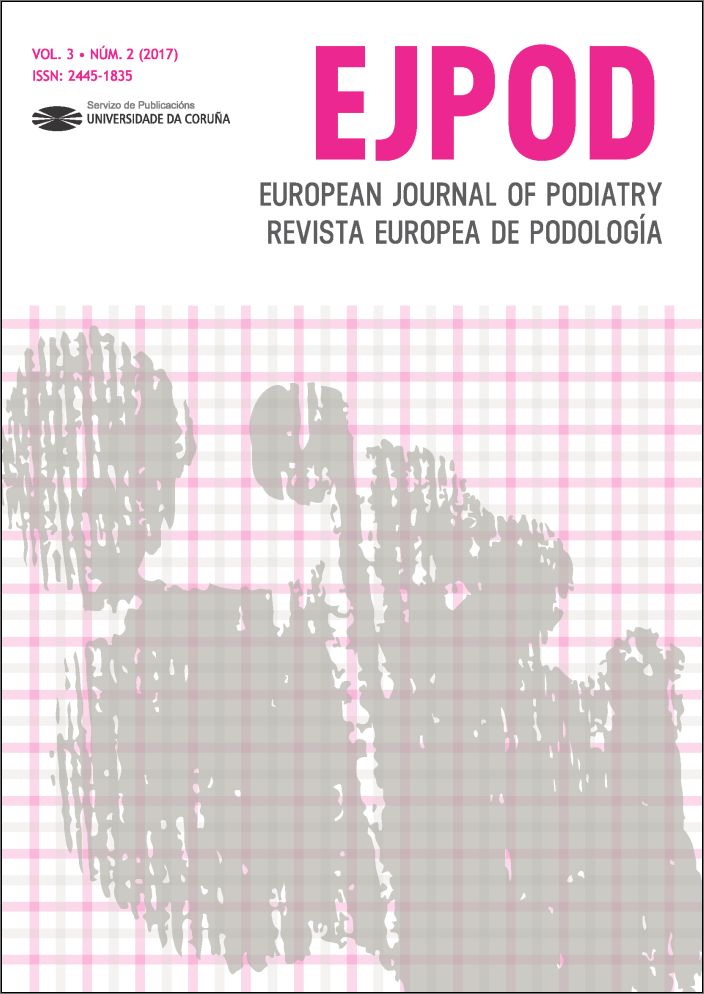Effects of body composition and basal metabolic rate the temporal parameters of ground reaction forces on gait of postmenopausal women
Main Article Content
Abstract
Objective: The study aims to identify and analyze the influence of body composition and basal metabolic rate over the behavior of temporal parameters of ground reactive forces during the gait of postmenopausal.
Methods: The experimental study was carry out with 52 women (±59.8 years). The fat mass, abdominal visceral adiposity, skeletal muscle mass, fat-free mass and basal metabolic rate have evaluated by octopolar bioimpedance. The data for the ground reactive forces were collect through the force platform.
Results: In relative terms, the fat mass showed influence the final phase of support, causing a decrease in this parameter. Abdominal visceral adiposity also exerted inverse influence on the vertical loading (r = -0.31) and unloading (r = -0.35) rate. The skeletal muscle mass (r = -0.45, r = -0.46; p<0.01) and basal metabolic rate (r = -0.44, r = -0.46; p<0.01) influenced the vertical loading rate and the relationship between the vertical rates significantly.
Conclusion: The study suggests that the increase on fat mass and abdominal visceral adiposity, influence the support time and the vertical rates. With a more robust skeletal muscle system the postmenopausal women exhibit the phases of the gait cycle less accentuated, signaling less stress on the joints.
Keywords:
Downloads
Article Details
References
Tchernof A, Despres JP. Pathophysiology of human visceral obesity: an update. Physiological Reviews 2013; 9: 359-404.
Aragão FR, Abrantes CG, Gabriel RECD et al. Effects of body composition and menopause characteristics on maximal oxygen upke of postmenopausal women. Menopause 2011; 18: 1-7.
Moreira MH, Passos B, Rocha J et al. Cardiorespiratory fitness and body composition in postmenopausal women. J. Hum Kinetics 2014; 43: 139-148.
Rolland Y, Vellas B. Sarcopenia. Rev Med Interne 2009; 30: 150-160.
Poehlman ET, Toth MJ, Gardner AW. Changes in energy balance and body composition at menopause: a controlled longitudinal study. Ann Intern Med 1995; 123: 673-675.
Janssen I, Heymsfield SB, Wang Z et al. Skeletal muscle mass and distribution in 468 men and women aged 18-88 yr. Journal of Applied Physiology 2000; 89: 81-88.
Hsu W, Fan C, Lin Z et al. Effect of basal metabolic rate on the bone mineral density in middle to old age women in Taiwan. Maturitas 2013; 76: 70– 74.
Marin RV, Pedrosa MA, Moreira-Pfrimer LD et al. Association between lean mass and handgrip strength with bone mineral density in physically active postmenopausal women. Journal of Clinical Densitometry 2010; 13: 96–101.
Sousa AL, Gabriel RECD, Faria MA et al. Behavior of temporal parameters of the ground reaction forces for the walking of postmenopausal women. Acta Bioengineering and Biomechanics 2015; 17:119-127.
LaRoche DP, Millett ED, Kralian RJ. Low strength is related to diminished ground reacion forces and walking performance in older women. Gait Posture 2011; 33: 668-672.
Ko S, Stenholm S, Ferrucci L. Characteristic gait patterns in older adults with obesity-Results from the Baltimore Longitudinal Study of Aging. Journal of Biomechanics 2010; 43:1104-1110.
Whittle MW. Gait analysis an introduction. Butterworth Heinemann Elsevier, 2007.
Shuster L, Rhodes D, Gostout B et al. Premature menopause or early menopause: long-term health consequences. Maturitas 2010; 65: 161-166.
WMA. Declaration of Helsinki: ethical principles for medical research involving human subjects. Fortaleza World Medical Association, 2013.
Harlow S, Gass M, Hall J et al. Group, SC. Executive summary of the stages of reproductive aging workshop +10: addressing the unfinished agenda of staging reproductive aging. Journal of Clinical Endocrinology & Metabolism 2012; 97: 1159-1168.
Cunningham JJ. Body composition as a determinant of energy expenditure: a synthetic review and a proposed general prediction equation. American Journal of Clinical Nutrition 1991; 54: 963-969.
Heyward VH, Wagner DR. Applied Body Composition Assessment. 2 ed. Champaign: Human Kinetics, 2004.
Biospace. Inbody 720, the precision body composition analyser. User’s guide. Seoul: Biospace Co, Ltd, 2004.
Völgyi E, Frances A, Tylavsky A et al. Assessing body composition with DXA and bioimpedance: effects of obesity, physical activity, and age. Obesity 2008; 16:700-705.
Gibson A, Holmes J, Desautels R et al. Ability of new octapolar bioimpedance spectroscopy analyzers to predict 4-component–model percentage body fat in Hispanic, black, and white adults. American Journal of Clinical Nutrition 2008; 87: 332-338.
Gabriel RC, Abrantes J, Granata K et al. Dynamic joint stiffness of the ankle during walking: gender-related differences. Phys Ther Spor. 2008; 9: 16-24.
McCrory JL, White SC, Lifeso RM. Vertical ground reaction forces: objective measures of gait following hip arthroplasty. Gait Posture 2001; 14: 104-109.
Winiarski S, Rutkowska-Kucharska A. Estimated ground reaction force in normal and pathological gai. Acta of Bioengineering and Biomechanics 2009; 11: 53-60.
Stacoff A, Diezi C, Luder G et al. Ground reaction forces on stairs: effects of stair inclination and age. Gait Posture 2005; 2: 24-38.
Stacoff A, Quervain IA, Luder G et al. Ground reaction forces on stairs part II: knee implant patients versus normal. Gait Posture 2007; 26: 48-58.
Larsen AH, Puggaard L, Hämäläinen U et al. Comparison of ground reaction forces and antagonist muscle coactivation during stair walking with ageing. Journal Electromyography Kinesiology 2008; 18: 568-580.


